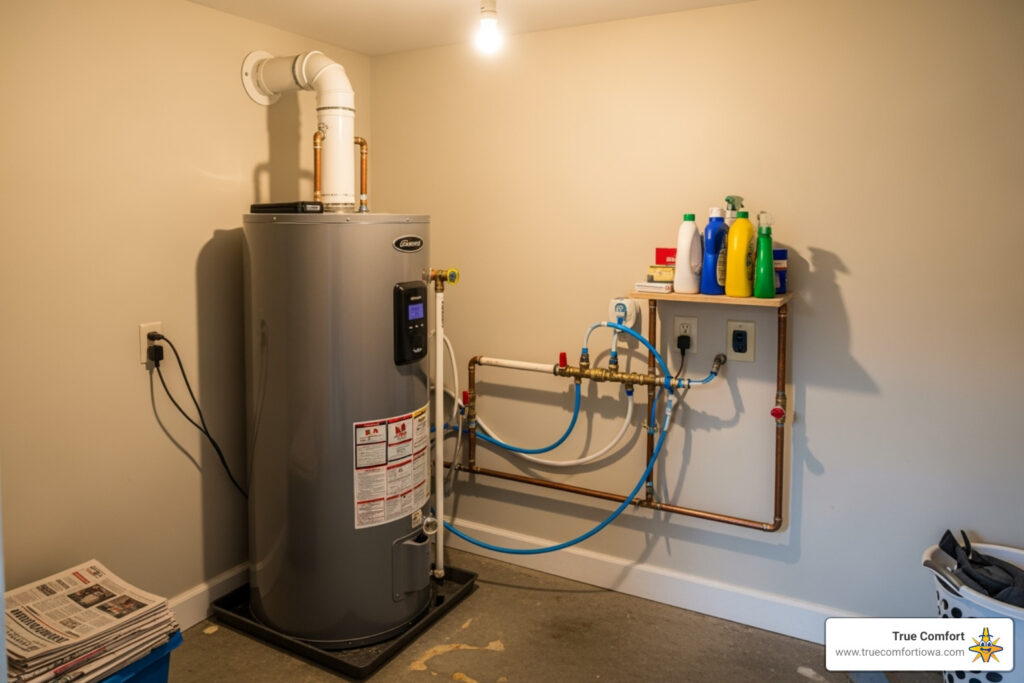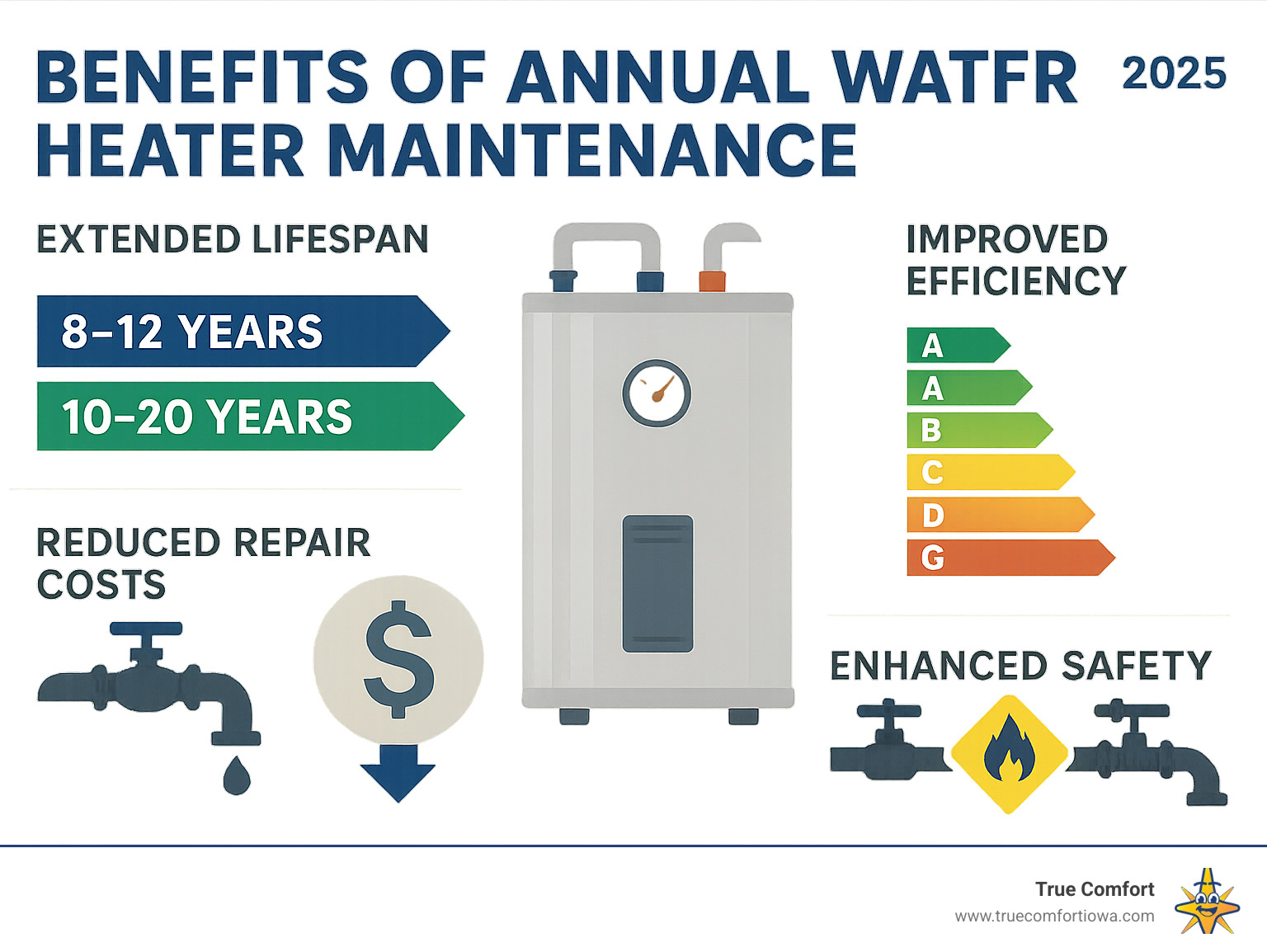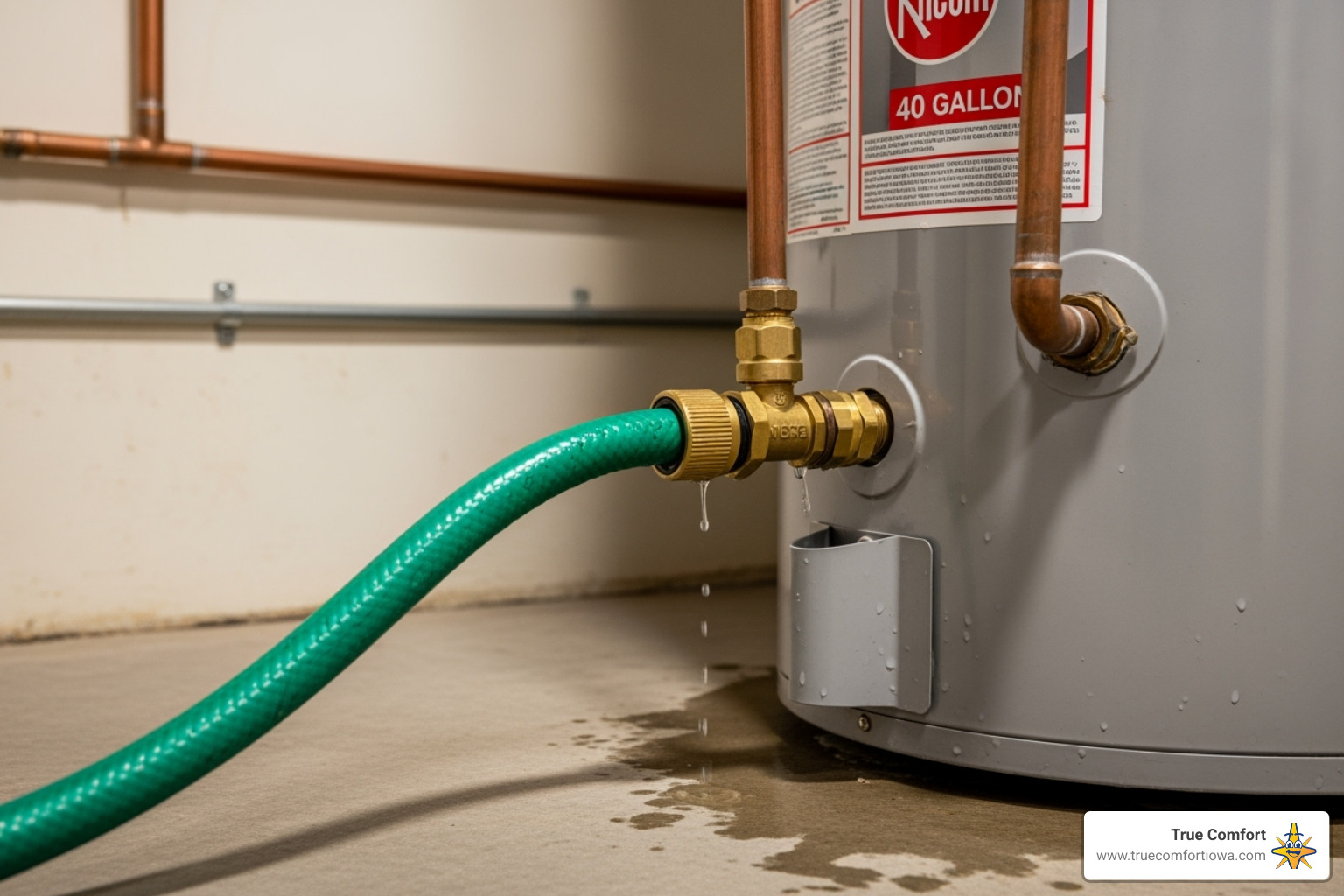Why Annual Water Heater Service Matters
Water heater annual service is essential for keeping your home’s hot water flowing reliably. Most homeowners don’t think about their water heater until something goes wrong, leading to cold showers and potentially costly repairs.
Key benefits of annual water heater service include:
- Extended lifespan – Regular maintenance can help your water heater last 10-12 years (or up to 20 years for tankless units)
- Improved efficiency – Flushing sediment and checking components keeps your system running at peak performance
- Improved safety – Testing pressure relief valves and inspecting gas connections prevents dangerous malfunctions
- Cost savings – Preventive care helps avoid expensive emergency repairs and reduces energy bills
- Consistent hot water – Proper maintenance ensures reliable performance when you need it most
As one of your home’s hardest-working appliances, a water heater needs regular attention. Without it, mineral deposits build up, components wear out, and efficiency drops, especially in areas with hard water. Many maintenance tasks are suitable for DIYers, while others require professional expertise. Knowing what to do—and when to call a pro—is key to proper water heater care.
Your Annual Water Heater Checklist: Key Components & Tasks
Think of your water heater annual service like a yearly physical for your home’s hardest-working appliance. The foundation of good maintenance starts with a simple visual inspection. Monthly, walk around your water heater and look for puddles, rust spots, or corrosion around pipe connections. This quick check can save you from major headaches.
To properly care for your water heater, you need to know its parts. The drain valve at the bottom is for flushing sediment. The Temperature and Pressure (T&P) valve is a critical safety feature that releases excess pressure. The anode rod is a sacrificial component that corrodes to protect the tank itself. The thermostat controls the water temperature. Electric models use heating elements, while gas models have a burner assembly and venting system. Understanding these components helps you spot problems early, like popping sounds from sediment or rusty water from a failing anode rod. For more details, check our guide on Signs Sediment Buildup in Water Heater.
Key Annual Maintenance Tasks
Your annual service routine should include these key tasks:
- Testing the T&P valve is a top priority for safety.
- Flushing the tank removes efficiency-robbing sediment.
- Inspecting the anode rod and replacing it if the core wire is showing or it’s caked with minerals can add years to your heater’s life.
- Checking the thermostat ensures your water is set to a safe and efficient 120°F.
- For gas and tankless models, cleaning air intakes and inspecting venting ensures safe operation.
The Impact of Water Quality on Maintenance
Your local water quality significantly impacts maintenance needs. Hard water, common in areas like Des Moines, contains minerals that settle in the tank, creating sediment. This buildup forces the heater to work harder, increasing energy bills and reducing its lifespan.
With hard water, you may need to flush the tank every six months instead of annually. A water softener can help you stick to a yearly schedule. Tankless water heaters are also sensitive to mineral deposits, which cause scaling. Learn more in our article on Tankless Water Heater Scaling Problems.
For additional guidance, the Water Heater Maintenance Guide from A. O. Smith provides manufacturer-specific recommendations.
Step-by-Step DIY Maintenance Procedures
We believe in empowering homeowners to tackle basic maintenance. Before starting, remember: safety first!
Here are the critical safety precautions:
- Turn off power: For electric heaters, switch off the circuit breaker. For gas heaters, turn the gas control valve to “OFF” or “PILOT”.
- Turn off gas supply: For gas models, turn the gas shut-off valve to the “OFF” position.
- Turn off water supply: Turn off the cold water inlet valve at the top of the heater.
- Handling hot water: Water in the tank is extremely hot. Allow it to cool before draining, or use extreme caution. Wear protective gloves and goggles. Know where your home’s main water shutoff is in case of an emergency.
How to Flush Your Water Heater Tank
Flushing the tank removes sediment, extending its lifespan and maintaining efficiency. Here’s how:
- Turn off the power/gas and cold water supply as described above.
- Connect a garden hose to the drain valve, directing the other end to a suitable drain.
- Open a hot water faucet (preferably on an upper floor) to let air into the system.
- Open the drain valve. Be cautious, as the water can still be hot.
- Drain until clear: Let the tank drain until the water runs clear, which may take 20-25 minutes. If draining is slow, briefly turn the cold water supply on and off to dislodge stubborn sediment.
- Close the drain valve and hot water faucet.
- Refill the tank by turning the cold water supply back on.
- Purge air: Once full, turn on a hot water faucet and let it run until water flows smoothly.
- Restore power/gas once the tank is full and air is purged.
Regular flushing can prevent issues like popping sounds. If your heater is already noisy, it’s time for a flush. Learn more in our guide on Water Heater Makes Popping Sounds.
How to Test the T&P Valve and Inspect the Anode Rod
Testing the Temperature and Pressure Relief Valve:
The T&P valve prevents dangerous pressure buildup. Testing it annually is crucial for safety.
- Locate the T&P valve on the top or side of the heater.
- Place a bucket under the discharge pipe.
- Test: Briefly lift the lever and let it snap back. A small burst of water should discharge into the bucket.
- Observe: If no water comes out, or if it keeps flowing, the valve is faulty and needs immediate professional replacement.
Inspecting the Anode Rod:
The anode rod protects the steel tank from corrosion.
- Turn off power/gas and cold water supply.
- Locate the anode rod (usually a hex-head bolt on top of the heater).
- Remove the rod using a socket wrench. This may require some force.
- Inspect for corrosion: If the rod is heavily corroded, or more than six inches of the core steel wire is visible, it needs replacement.
- Replace or reinstall: Reinstall the rod if it’s in good condition. If replacing, use the correct type and size for your model.
- Restore water and power/gas after the rod is securely in place and the tank is refilled.
Understanding Your Specific Water Heater
Proper maintenance includes knowing your specific water heater type. One of the most impactful adjustments is setting the correct temperature.
We recommend setting your water heater thermostat to 120°F. This provides ample hot water while preventing dangerous scalding, which is especially important for homes with children or elderly family members. Gas water heater thermostats are typically a dial on the gas control valve. Electric models have thermostats behind access panels on the side of the tank.
Pro Tip: Make temperature changes in 10-degree increments, waiting a few hours to test the water at a faucet. This prevents overshooting your target temperature. If you have inconsistent or no hot water, the thermostat could be the issue. Troubleshoot with our guide on Water Heater Thermostat Problems.
Maintenance Differences: Gas, Electric, and Tankless
While some water heater annual service tasks are universal, each system has unique needs.
| Maintenance Task | Tank (Gas) | Tank (Electric) | Tankless |
|---|---|---|---|
| Flushing/Descaling | Annually (more with hard water) | Annually (more with hard water) | Annually (more with hard water) |
| T&P Valve Test | Annually | Annually | Annually |
| Anode Rod Inspection | Annually (replace ~7 years) | Annually (replace ~7 years) | N/A (most don’t have them) |
| Thermostat Check/Adjust | Annually | Annually | Annually (check temperature sensor) |
| Pilot Light/Burner Check | Annually (clean burner assembly) | N/A | N/A |
| Heating Elements Check | N/A | Annually (inspect for wear) | N/A |
| Venting System Check | Annually (for obstructions/leaks) | N/A | Annually (for obstructions/leaks) |
| Air Intake Filter Clean | Annually | N/A | Annually |
| Inlet Filter Clean | N/A | N/A | Annually |
Gas water heaters require checking combustion components. This includes ensuring the pilot light is lit and cleaning the burner assembly. The venting system is critical for safety and must be inspected for blockages and secure connections.
Electric water heaters have heating elements inside the tank that must be inspected for corrosion or sediment buildup, which reduces efficiency.
Tankless water heaters can last up to 20 years but require annual descaling to remove mineral buildup from the heat exchanger. You should also clean the inlet filter. This maintenance is critical for longevity. Learn more in our guide on Tankless Water Heaters Efficient Choice.
When to Call a Professional for Your Water Heater Annual Service
While many tasks are DIY-friendly, some water heater annual service issues require a professional. Certain problems are too complex or dangerous to handle without proper training and tools.
Call a pro for:
- Gas line problems: If you smell gas, shut off the supply and call for help immediately. Gas leaks are extremely dangerous.
- Major electrical work: Replacing heating elements or diagnosing electrical faults involves high voltage and should be left to experts.
- Persistent leaks: A professional can determine if a leak is a simple fix or a sign of a corroded tank needing replacement.
- Unusual sounds or odors: If basic maintenance doesn’t resolve strange noises or smells, it indicates a deeper problem requiring professional diagnosis.
Our golden rule: if you’re ever unsure or uncomfortable, stop and call us. It’s always better to be safe than sorry.
Signs Your Water Heater Needs Professional Repair or Replacement
Your water heater will show signs when it needs professional help. Look for these warnings:
- Leaks or puddles: Puddles around the base often mean the tank is corroded and needs replacement.
- No hot water or running out quickly: This could be failed heating elements, a bad thermostat, or severe sediment buildup.
- Inconsistent temperatures: Often points to a failing thermostat or a broken dip tube.
- Discolored water: Rusty or brown hot water indicates internal tank corrosion and that replacement is imminent.
- Strange noises: Banging or rumbling usually means hardened sediment at the bottom of the tank.
- Foul odors: A “rotten egg” smell signals bacterial growth in the tank.
- Unit age: If your tank heater is over 8-12 years old (or tankless is over 20), start planning for a replacement.
When you notice these signs, don’t wait. Our team can diagnose the issue. For more details, see our guide on Signs You Need Water Heater Repair.
The Role of Insulation in Efficiency
An easy and effective upgrade is insulation. Insulating your water heater tank with a blanket reduces heat loss, saving energy and reducing wear on the system.
Insulating the first six feet of both hot and cold water pipes also helps. Hot water stays hotter longer, and cold water pipes are protected from freezing in Iowa’s harsh winters. This small investment improves efficiency, extends unit life, and prevents costly damage from burst pipes.
Frequently Asked Questions about Water Heater Maintenance
We’ve answered countless questions about water heater care. Here are the most common ones.
How often should I perform water heater maintenance?
Annual water heater service is the standard recommendation. This includes testing the T&P valve, inspecting the anode rod, and checking the thermostat and venting system (for gas models). However, if you have hard water, like many in the Des Moines area, you should flush the tank every six months to prevent sediment buildup. Always check your manufacturer’s guidelines for model-specific recommendations.
What are the most critical safety precautions for DIY maintenance?
Safety is non-negotiable. Before starting any work:
- Turn off the power/gas: Shut off the power at the circuit breaker for electric models, or turn off the gas supply valve for gas units.
- Shut off the water: Turn off the cold water supply valve to the heater.
- Wear protective gear: Use gloves and safety goggles, as the water inside is extremely hot. Let it cool before draining if possible.
- Know your main shutoff: Locate your home’s main water shutoff valve beforehand in case of an emergency.
What are the signs my water heater is leaking and what should I do?
Water heater leaks are a serious sign that should not be ignored. Look for puddles around the base, drips from pipes, or rust streaks on the tank’s sides.
If you find a leak, act quickly. Immediately shut off the cold water supply valve and then turn off the power or gas supply. This prevents further water damage and stops the unit from heating an empty tank.
Once the unit is safe, call a professional. Even small leaks can cause significant damage or indicate that the tank is failing. Our team can assess whether it’s a simple fix or time for a replacement. When it comes to leaks, it’s always better to be safe than sorry. Contact us for Water Heater Repair as soon as you notice trouble.
Ensure Your Home’s Comfort with Proper Maintenance
Proper water heater care is a manageable part of home ownership that pays dividends. Your water heater works 24/7, and investing a few hours each year in water heater annual service ensures its longevity, efficiency, and safety, giving you peace of mind.
Key tasks like flushing sediment, testing the T&P valve, and inspecting the anode rod are proven strategies to help your unit reach its full lifespan. Whether you perform DIY tasks or call a professional, consistency is crucial.
Some maintenance is perfect for DIYers, while other issues involving gas lines or major electrical work require the safety and expertise of trained professionals. There’s no shame in calling for help when you want the assurance that the job is done correctly.
At True Comfort, we serve homeowners throughout the Des Moines area, from Windsor Heights and Urbandale to Ankeny and Ames. We understand how important reliable hot water is to your daily routine and believe in honest assessments and quality workmanship.
For comprehensive and professional service in the Des Moines area, trust the experts at True Comfort. We’re here to help keep your home comfortable year-round. Schedule your water heater repair in Des Moines, IA today!






